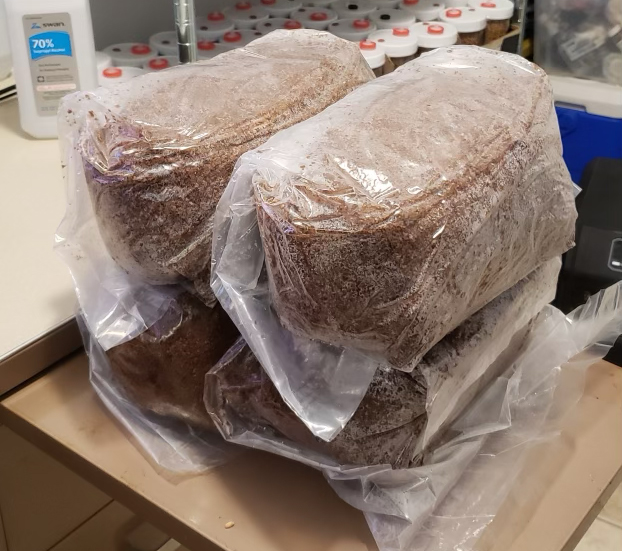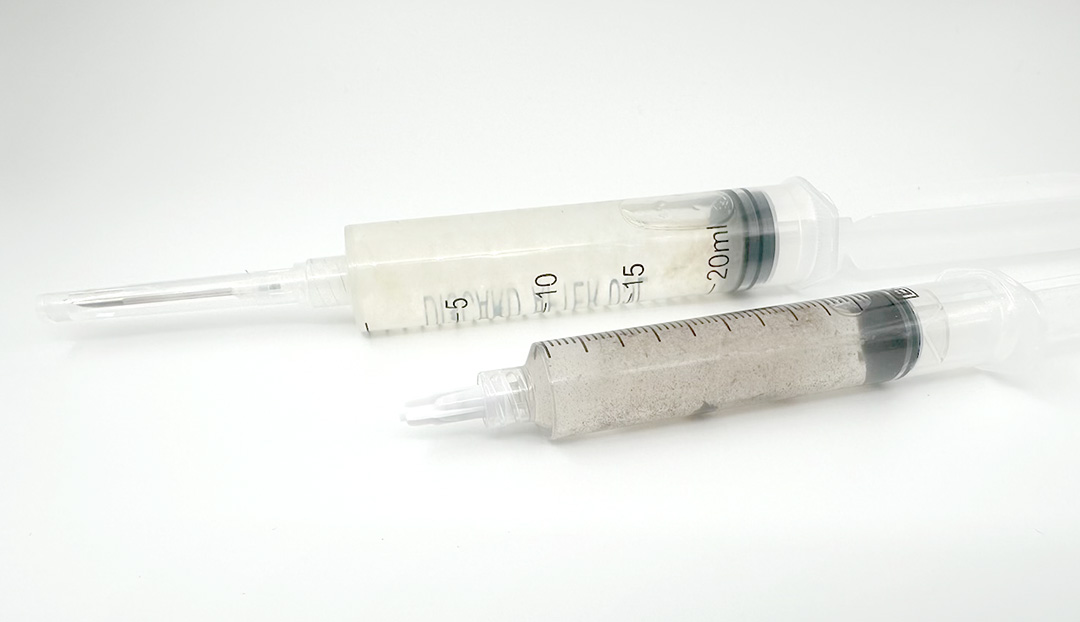Have you ever wondered where a mushroom gets its start, or how to grow mushrooms indoors? Then you’re in luck because today we’ll be taking a look at mycelium: what it does, and why it’s so important to mushroom cultivation.
Unsung Hero
Mycelium is essentially an underground network, a mycological internet if you will. It’s a mess of branched, thread-like structures called hyphae. Hyphae is that fuzzy looking stuff that develops on your grandma’s 2 week old tomato bisque.
 Microsope view of hyphae with blue stain applied
Microsope view of hyphae with blue stain applied
The hyphae that make up the mycelium is what absorbs and transports nutrients, supporting the growth of the caps and stems that end up getting all the attention.
Home Life
Obviously, we don’t want to have grandma make bisque every time we want to grow shrooms. Enter substrate, a cornerstone upon which we can build a mycelium kingdom. This is essentially the “sack of dirt” that grow blocks seem to be.
 Uncolonized grow bags looking like dirt
Uncolonized grow bags looking like dirt
What’s inside can actually vary quite a bit depending on the nutritional needs of the mushroom being grown. Two common substrates include straw for Oyster mushrooms and sawdust or wood chips for Shiitake or Lion’s Mane. Substrate is essentially the Wheaties your mushrooms need to eat.
 Straw is commonly used for Oysters but must be processed from its raw form pictured here
Straw is commonly used for Oysters but must be processed from its raw form pictured here
Keeping It Clean
As they’re starting out, mushrooms are highly susceptible to competition from microorganisms such as bacteria, molds, and even other fungi. These competitors will outcompete the desired mushroom mycelium for nutrients and space, resulting in reduced yields, low nutritional content, and even complete inability of the mycelium to colonize.
 Bags of sterilized substrate prior to colonization by mycelium
Bags of sterilized substrate prior to colonization by mycelium
This is why substrate must always be fully sterilized; pressure cooking is a popular method. We have a blog post covering sterilization in the works so stay tuned!
Spawn Time
The two main methods that most people use to inoculate their substrate are spore syringes and liquid cultures.
 Spore (bottom) and Liquid Culture (top) Syringes
Spore (bottom) and Liquid Culture (top) Syringes
Spore syringes contain dormant spores, essentially mushroom seeds (there is some hand waving here as they’re not exactly like seeds), but in this context we can consider a spore syringe to effectively be the same thing. Liquid cultures take spores to the next level by including living, active mycelium. The liquid culture is a nutrient-rich solution that provides the mycelium with the sustenance it needs for quicker colonization.
However, as with most things in life, there are tradeoffs between the two methods. While liquid cultures tend to offer faster growth, the solution also has shorter shelf life compared to spore syringes and must be kept in an airtight container to remain viable.
Looking Healthy
Healthy mycelium should always be propagating. Signs of good health include a white, web-like appearance absent of any funky colors or smells. If your mycelium isn’t growing or looks dry, usually some additional moisture or change in temperature will do the trick. Contamination is as bit more tricky to rectify but we’ll save troubleshooting mycelium issues for another time as it’s very much a subject in and of itself.
The Magic
So.. How does mycelium know when to turn into mushrooms? The answer is high humidity, ideal temps, plentiful fresh air exchange, and careful light stimulation.
 Example of fantastic mycelium coverage from Forest Origins, just cut the X to start!
Example of fantastic mycelium coverage from Forest Origins, just cut the X to start!
All you have to do is slice open a hole in your bag of substrate, allow contact with a humid environment that has sufficient oxygen (growing mushrooms consume large amounts of O2 and produce CO2, unlike plants with chlorophyll), and sprinkle in a light source. It’s a bit like conducting an orchestral masterpiece where the crescendo is hopefully massive fruiting bodies.
Don’t lose hope if it doesn’t work out the first couple times, there are many environmental variables to control with growing anything indoors, especially mushrooms.
Luckily, if you don’t want to do all that, OttoENV will do it for you. The OttoENV grow system features a controller that sports an RH sensor + humidifier to maintain ideal humidity levels, a temperature sensor for accurate readouts, and most importantly, a CO2 sensor to prevent moisture loss by only running the fans when there’s not enough oxygen in the tent. Stay up to date with our Kickstarter launch by signing up for launch notification on Kickstarter
 Lion’s Mane grown using OttoENV
Lion’s Mane grown using OttoENV







